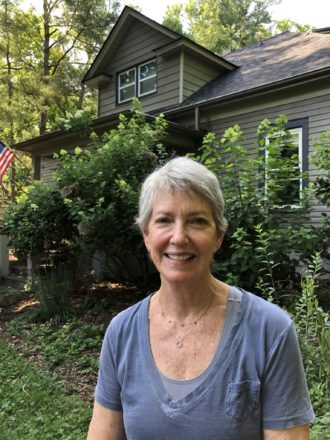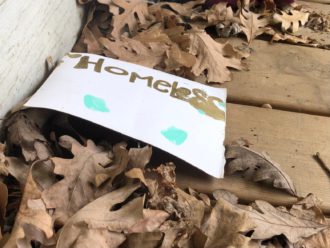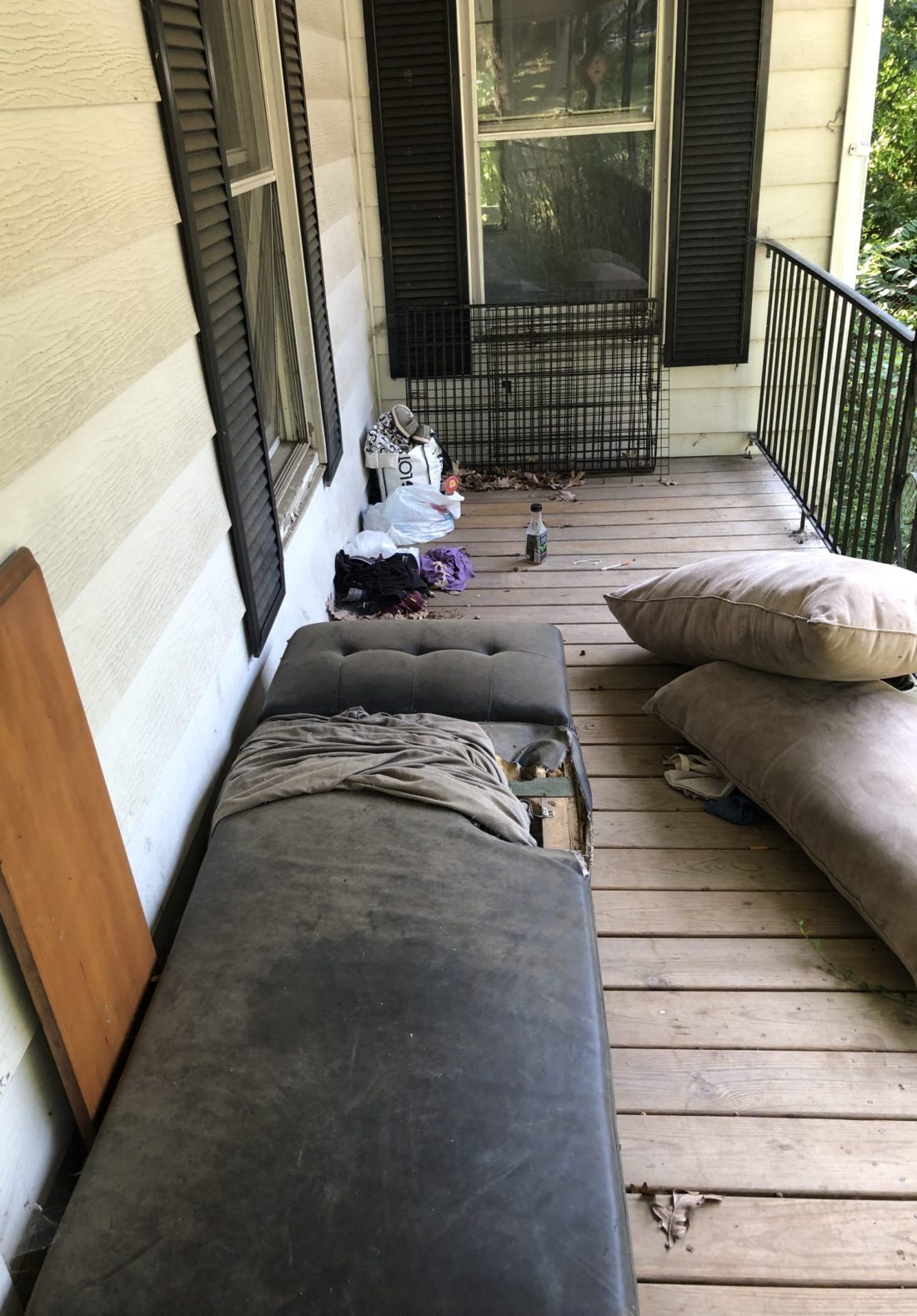by
Residents of East West Asheville say vacant homes now owned by the NCDOT to make way for the upcoming I-26 Connector project have become havens for drug users and people experiencing homelessness.
Cathy Sherman said she moved to Asheville eight years ago and bought a house just off Hanover Street in part because the socio-economically mixed neighborhood appealed to her. Some crime and apparently unhoused people have always been part of the landscape, but in the last several months she says, “the neighborhood has been inundated with homeless and drug users.
“Now that the DOT has started buying houses on Hanover to tear down it has gotten worse,” Sherman told Asheville Watchdog. “The empty houses are being used as shelters for drug users, which I have personally seen and called the police about.”
Sherman said she’s called the Asheville Police Department and the North Carolina Department of Transportation multiple times, in the latter case asking the NCDOT to lock or board up these houses.
Chuck Reissig, Sherman’s neighbor on Alabama Avenue, is a stay-at-home dad who lives on the corner with his wife and two small children and has an unobstructed view of two of the empty Hanover Street houses from his own porch. He also said he has contacted the police and transportation departments. Over the last five years or so, Reissig said, residents have had to deal with a neighborhood drug dealer, a scary and dangerous situation that was recently resolved.
But since about April, when tenants moved out of the NCDOT-owned buildings, problems have escalated with the now-vacant properties. Neither he nor Sherman have had break-ins or other crime at their homes, although Reissig said someone stole a decorative lantern from the yard and Sherman had a bike stolen a few years ago.
Asked what kinds of behaviors he’s witnessed at the vacant homes recently, Reissig reeled off a list of woes. “They say, basically, it’s in process and that locking them won’t deter the vagrants from getting into the houses,” Sherman said. “There are constantly people passed out on Hanover, and the corner of Hanover and State Street looks like a movie about drugs.”
“They say, basically, it’s in process and that locking them won’t deter the vagrants from getting into the houses,” Sherman said. “There are constantly people passed out on Hanover, and the corner of Hanover and State Street looks like a movie about drugs.”
“People living in the porches and behind the houses, breaking and enterings, people defecating,” Reissig said. “I don’t even want to go up to those properties because of my safety. I’m not going to confront these people on any of this.”
APD, NCDOT aware of the issues
Asheville Police Department spokesperson Rick Rice said the department is “aware of the issues in the area of Hanover and State Streets and the surrounding communities.
“Criminal activity and quality-of-life issues in this area have been prevalent for some time,” Rice said. Officers “routinely conduct extra patrols” in the area, he said.
Rice said the APD has spoken to NCDOT and “requested better security and signage” at the vacant properties.
“Demolition of these properties would make them less attractive targets, and we recognize and appreciate that NCDOT is trying to expedite that process,” Rice said.
Reissig said he heard personally from Police Chief Mike Lamb about the recent developments, but overall he’s not seen much action out of the police or NCDOT.
Sherman said she’s seen numerous people who appear to be living in or near a bus shelter on Hanover Street, and large groups of apparent drug users congregate at Hanover and State streets.
“Hanover has become a drug alley,” she said. Sherman also has become frustrated with the lack of NCDOT or police action, noting it’s obvious which homes are vacant because the grass and weeds are waist-high, and some yards and porches have trash in them.
David Uchiyama, NCDOT spokesman for the western part of the state, confirmed that the department has acquired multiple properties in the area that resulted in relocating owners.
“As of July 3, 27 properties have been acquired and currently stand in the planning phase of building removal,” Uchiyama said via email.
The demolition process takes time, though.
“The building removal process consists of three phases, starting with an inspection for potential asbestos, abatement of any asbestos, and finally physical demolition of the structure or structures,” Uchiyama said. “This process usually takes approximately two to three months, depending on the asbestos inspection.”
Some older homes from the early-to-mid 20th century were built with asbestos shingles or siding, as well as asbestos insulation.
Sixteen properties are scheduled to be inspected, Uchiyama said. Nine are awaiting asbestos abatement and two are scheduled to be demolished within two weeks.
“NCDOT is working to accelerate the demolition process as much as possible, and is coordinating with the Asheville Police Department to reduce disturbances and illegal activity in the area,” Uchiyama said.
As far as boarding properties up, that is the responsibility of the contractor checking the properties for asbestos abatement, Uchiyama said, noting that all parties involved want the buildings boarded up. Some boarding of the homes could begin in the next few weeks, Uchiyama said, and contractors will strive to board up as much of the homes as possible, including porches.

Demolitions could start in early fall, Uchiyama siad.
The road project’s funding restrictions prevent NCDOT staff from mowing or cutting back weeds, Uchiyama said.
The NCDOT has worked on land acquisition and right of way on three of the five sections for the I-26 Connector project for two years The project, which ultimately will connect northern and southern portions of I-26, will affect 175 property owners — 154 residential and 21 non-residential.
In mid-May the NCDOT awarded the contract for the two main sections of the project to Archer-Wright Joint Venture, which put in a $1.15 billion bid. The project will require widening of I-240 in West Asheville, which is why the NCDOT has acquired homes along Hanover Street and other nearby areas.
‘It’s just gotten really bad’
Sherman recounted her conversation with the NCDOT about the vacant homes.
“I’m like, ‘Look, you’ve got people living in there. They’re drug people. They’re homeless people,” Sherman said. “Could you at least lock the gate? They said, ‘Well, it’s really not going to keep them from getting in.’ So they really wouldn’t do anything about it.”
Last week, two of the homes, at 95 and 97 Hanover, showed evidence of people staying or sleeping on the porches, including discarded clothing, bedding, and food trash. Each porch also had a discarded syringe on the flooring.
The NCDOT owns both vacant homes, according to Buncombe County property records.
Sherman said she’s sympathetic to the unhoused people, and she supports needle exchange programs because they work to reduce transmission of disease. But the Hanover/State Street area, reaching up to Haywood Road, West Asheville’s main corridor near I-240, has begun to feel “like a scene from The Walking Dead,” Sherman said, referring to the apocalyptic television show about zombies.
She understands the NCDOT must conduct asbestos abatement, and that it cannot expedite demolition on the stretch of Hanover Street near Alabama.
“But in the meantime, we’ve got eight houses sitting empty,” Sherman said, adding that the yards are unmowed and littered. “One of them I was driving by on a Saturday morning, and there were two people on the sofa in front of the house smoking, and I guess it was crack. It wasn’t a cigarette. So I called the police. I’ve found people passed out up on Haywood. I called the police, because I don’t know if they’re dead. It’s just gotten really bad.”
Sarah Sheeran, who lives with her husband Rob Sheeran and their two young children on Hubbard Avenue, not far from Hanover Street on the other side of I-240, said several nearby houses that the NCDOT took through eminent domain apparently have also become havens for drug users. She’s spotted needles around some of the abandoned homes, as well as people coming and going.
“It’s just a little, I think, alarming when our kids are walking up and down the street,” Sarah Sheeran said. “I’m not fearful by any means that anything is going to happen, and it’s not that I have any real issue with the homelessness. But I think it is just the drug issue that bothers us.”

Sheeran said she has contacted the police, but she doesn’t know if they came out to investigate.
“I don’t think it’s really a priority for them,” Sheeran said.
Asked if she’s noticed increased police patrols, Sheeran said, “I walk that neighborhood every day. Maybe we’re missing each other, but I haven’t noticed increased patrols on the times that I’ve been outside or on the street.”
She also reached out to the NCDOT and was told the agency was aware of the situation and working to get the demolitions done. After meeting with the NCDOT at the end of April, Sheeran said, officials told her they were aware of the situation, but it would probably be about six to nine months before the demolitions could be completed.
To make some of the homes look inhabited, Sheeran said, she and her husband have actually done some weed whacking along the road aprons.
“With the homeless situation that Asheville is facing, I don’t really blame folks for taking advantage of the opportunity,” Sheeran said. “But when you do have folks who are on drugs, sometimes behaviors are unpredictable.
Asheville Watchdog is a nonprofit news team producing stories that matter to Asheville and Buncombe County. John Boyle has been covering Asheville and surrounding communities since the 20th century. You can reach him at (828) 337-0941, or via email at jboyle@avlwatchdog.org. The Watchdog’s reporting is made possible by donations from the community. To show your support for this vital public service please visit avlwatchdog.org/donate.




Raising awareness about this huge problem in West AVL caused and allowed by the incompetent city council and mayor.
It says SEVERAL times that the houses are owned by NCDOT. How is it City Council or the Mayor’s responsibility?
Is that a serious question? The houses, regardless of ownership, are located within the jurisdiction… And, well, that jurisdiction has the responsibility to enforce all apllicable laws.
It is the responsibility of Law Enforcement to identify and eliminate crack houses REGARDLESS of who owns them .. Be they a resident crack dealer or absent owner who has given up on the property. DOT SHOULD go ahead a bulldoze the houses though.
If you create one of Kamala’s Venn diagrams containing two sets: (A) Unhoused people in AVL (B) users of illegal or illegally obtained drugs, you will see that the intersection set A with the complement of set B is nearly empty.